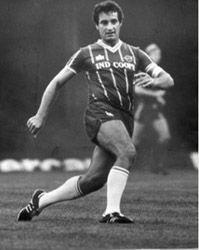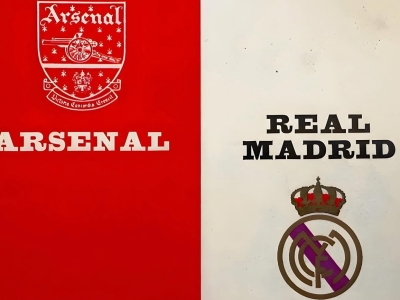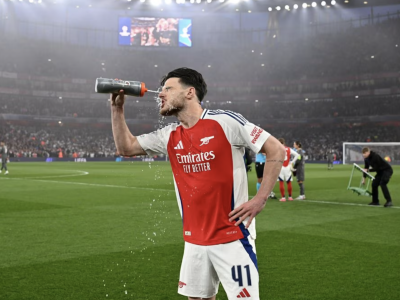Leicester City were founded by a group of former members of Wyggerstone Grammar School for Boys - whose alumni includes both David and Richard Attenborough - as Leicester Fosse F.C. in 1884, as they played their homes games at a field in Fosse Road in Leicester. The club moved to Filbert Street in 1891 and joined the Football League in 1894/95. The club first met Woolwich Arsenal in January of that season with the Fosse winning 3-1. In 1919, the town of Leicester was granted city status and accordingly Leicester changed their name to Leicester City. Leicester have never won a league title, but missed out by just one point in 1928/29 to Sheffield Wednesday. One of the earliest noteworthy fixtures between Leicester and Arsenal came the following season in April 1930, just five days ahead of the 1930 FA Cup Final.
The match turned out to be the highest ever scoring draw for a Football League fixture, ending 6-6. Arsenal fielded a weakened side ahead of the Cup Final with four goals for squad player David Halliday who moved on to Man City the following season (the other two were scored by Cliff Bastin). Also playing his last game was the hapless Dan Lewis, whose error cost Arsenal the 1927 FA Cup Final and was dropped ahead of the 1930 Final. The earliest available footage for an Arsenal visit to Leicester City’s Filbert Street comes from January 1935 when the two sides met in the fourth round of the FA Cup. Arsenal went through with a 1-0 win, with a goal scored by Joe Hulme.
Sadly, the lower scoring fixture of the three matches between the sides that season was the one captured on film. A month earlier at Highbury, Arsenal thrashed the Foxes 8-0 with hat-tricks for Joe Hulme and Ted Drake, as well as two goals for Cliff Bastin. Arsenal returned to Filbert Street in late April to secure their third consecutive league championship, needing only a draw. Arsenal went on to win 5-3 with two goals for Jack Crayston, two for Pat Beasley and one from Robert Davidson. Six years later, during World War Two, Arsenal met Leicester in the war time Football League Cup Semi Final in 1941. The Gunners took a 1-0 lead to Filbert Street, eventually winning through to the final with a 2-1 win. Arsenal however would lose the final to Preston North End.
Leicester would spent the early post-war period in the second tier, however while down there reached their first ever FA Cup final in 1949. Leicester defeated Portsmouth in the Semi-Final at Highbury 3-1, with Field Marshall Montgomery (the man who masterminded the allied victory in the second Battle of El-Alamein in late 1942, generally considered a major turning point in WW2 in favour of the allies) in attendance @00.18. Pompey at the time were leading the top tier and that year would win the first of their back to back league titles. Leicester went on to meet fellow Midlanders Wolves in the final, however were defeated 1-3. One notable absentee for Leicester in the Cup Final had been future Leeds United manager Don Revie who was forced to miss out due to an injury to his nose. Leicester City have never won the FA Cup, however did reach the final again on three separate occasions, all of which came during the 1960s – which became the first halcyon age for Leicester City under the management of Matt Gillies.
The next final came in 1961 against that year’s run away league champions (and never again!) Tottenham Hotspur. The Leicester side that day included future England World Cup winner Gordon Banks and future Arsenal Double winning captain Frank McLintock. Sadly, the Foxes were beaten 0-2 leading to Spurs achieving the first League and FA Cup double of the twentieth century. Leicester City would return two years later to play Manchester United, however would lose 1-3 to Manchester United with goals from Denis Law and two for former Arsenal striker David Herd. Leicester would also finish that term in fourth position, however Frank McLintock would leave the Foxes the following October citing the club’s ‘lack of ambition’, as well as being unhappy with Leicester’s contract offer and a feeling that his chance to win Cup and Scottish Caps lay elsewhere.
Frank of course went on to great things too with Arsenal, finally winning at Wembley in 1971 after two further defeats in the League Cup against Leeds United in 1968 and Swindon in 1969. Frank would indeed go on to become such a recognisable figure in the game that even random people on tube trains with camera phones would capture footage of him having forty winks on the tube and upload it on social media! The following season however Leicester City would win a two-legged League Cup Final against Stoke City, holding the potters to a 1-1 draw at the Victoria Ground before winning the second leg at Filbert Street 3-2, to win the tie 4-3 on aggregate. Leicester would reach the final of the League Cup again for the second successive season in 1964/65, however would lose 3-2 in the first leg to Chelsea at Stamford Bridge and held to a 0-0 draw back at Filbert Street.
Leicester during the 1960s however were not only lucky to have who many people considered to be the world’s best goalkeeper in Gordon Banks, but an up and coming reserve goalkeeper in Peter Shilton who actually displaced Banks as Leicester’s number one goalkeeper within a year of his 1966 World Cup heroics. Shilts was eager to make his mark and not willing to wait in reserve behind Gordon Banks in the pecking order, leading to Banks being sold on to Stoke City by the close of that season. Peter Shilton arguably went on to become as much as a goalkeeping legend as Banks and along with our own David Seamen is among the top three all-time English goalkeepers.
This here is his episode of ‘This is Your Life’ from 1986 and also surprising Shilts at London’s Waterloo Station dressed as British Rail porters along with Eamonn Andrews and his red book are three Arsenal and England internationals in Kenny Sansom, Tony Woodcock and Viv Anderson, accompanied by Tottenham’s Glenn Hoddle and Chris Waddle. Shilts would appear in Leicester's last final appearance at the end of the decade. During the 1968/69 season after a poor start to the season, Matt Gillies resigned in November and was replaced by Frank O'Farrell, who was unable to prevent Leicester's slide to the second tier. Worse was to follow when the Foxes were on the receiving end of a 0-1 defeat to Mercer and Allison's Manchester City.
Frank O’Farrell would get Leicester City back into the top flight within two seasons, gaining promotion in 1970/71. O’Farrell however would be poached by Manchester United during the close season of 1971, to take over after Sir Matt Busby’s brief return from retirement (though the hapless O’Farrell would last just eighteen months within the role). On account of Arsenal snubbing the 1971 Charity Shield, Leicester competed against FA Cup runners up Liverpool and win 2-1. Aside from Leicester City’s return to top flight Football, the city also made the headlines around this time for matters very similar to that which had dominated the news in recent weeks. Former western ally Idi Amin (whose story is portrayed in the excellent 2007 biopic ‘Last King of Scotland’) had decided in August 1972 to expel Ugandans of South Asian origin (many of whom were descendants of workers brought over to the African nation by the British Empire) within ninety days, many whom were holders of British passports and resettled in the Leicester area on arriving in the UK, with local opposition leading to councils in Leicester to place adverts in the press to discourage Ugandan Asians heading to the city (a move which they retrospectively regretted).
On the Football side of things, after 1971 under former Arsenal forward Jimmy Bloomfield Leicester remained in the top flight for the longest period in their history, with noted stars such as Keith Weller, Frank Worthington and former Arsenal man Jon Sammels. One star on the way out of Leicester however was Peter Shilton for a world record fee for a goalkeeper to Stoke City. Apparently, according to this blog, Shilts was also a target for Arsenal after they lost Bob Wilson who retired in 1974. From around this period Leicester were very nearly upended in the FA Cup by non-league side Leatherhead (as well as a ruck between Leicester players Dennis Rofe and Alan Birchenall @05.58), however pulled back a two goal deficit with captain Jon Sammels scoring their first to win 3-2
Bloomfield left Leicester in 1977 and sadly passed away from cancer just six years later in 1983 at the age of just forty nine. He was replaced by another former Arsenal man Frank McLintock who was allegedly forced to sell Frank Worthington to Bolton so the latter could receive a signing on fee and higher wages in order to avoid bankruptcy. He also signed two former Arsenal team mates in Eddie Kelly and George Armstrong, though both of whom were coming to the end of their careers, as was former Chelsea defender David Webb and former Derby County forward Roger Davies. Frank resigned as Leicester manager at the end of 1977/78 season as the Foxes were relegated to the second tier, where they would spend four of the next five seasons until, as will be seen tomorrow, they would return to the top flight in the mid to late eighties with a new batch of talent.
*Follow me on Twitter@robert_exley








